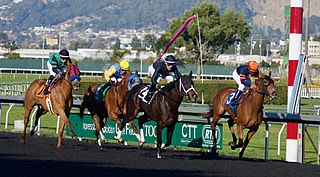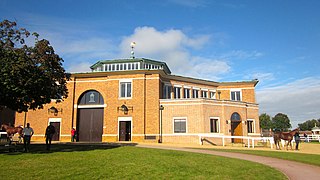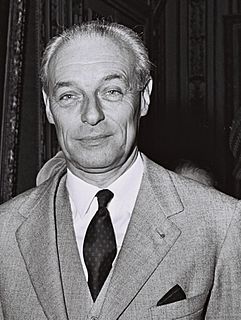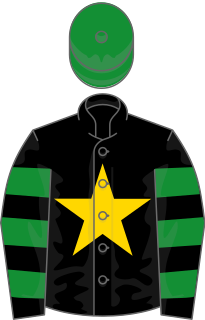Storm Bird was a Canadian-bred, Irish-trained Thoroughbred racehorse and sire. He was the outstanding European two-year-old of 1980, when he was unbeaten in five races, including the Anglesey Stakes, National Stakes, and Dewhurst Stakes. His subsequent career was disrupted by injury and illness, and he was well beaten in his only race of 1981. He was then retired to stud, where he became a successful breeding stallion.
Theatrical was an Irish-bred Thoroughbred racehorse who won the 1987 Breeders' Cup Turf and was a successful sire.
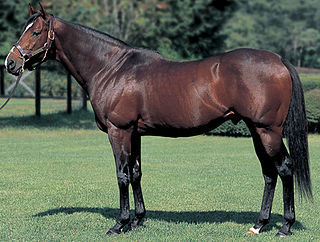
Tony Bin (1983–2000) was an Irish-bred Thoroughbred racehorse who competed in Europe for his Italian owner from a base in Milan and became a leading sire in Japan.
Right Royal (1958–1973) was a French Thoroughbred race horse and sire. He was the best two-year-old in France in 1960 when his wins included the Grand Criterium. He was the dominant three-year-old of his generation in Europe in the spring and summer of 1961, winning the Poule d'Essai des Poulains, Prix du Jockey Club and the King George VI and Queen Elizabeth Stakes. Right Royal was defeated in the Prix de l'Arc de Triomphe and was retired to stud where he had some success as a breeding stallion.
Reliance was a French Thoroughbred racehorse and sire. Unraced as a two-year-old, Reliance won his first five races as a three-year-old in 1965 including the Prix du Jockey Club, Grand Prix de Paris and Prix Royal Oak. He sustained his only defeat when finishing second to Sea-Bird in the Prix de l'Arc de Triomphe. He was then retired to stud where he had some success as a sire of winners.
Supreme Court (1948–1962) was a British Thoroughbred racehorse and sire. After winning the Horris Hill Stakes as a two-year-old, Supreme Court was undefeated in four races as a three-year-old in 1951, taking the Chester Vase and King Edward VII Stakes before beating a strong international field to win the inaugural King George VI and Queen Elizabeth Stakes. Following his win in the most valuable race ever run in Britain, Supreme Court was retired to stud, where he had some success as a sire of winners.
Bolkonski was an Irish-bred, British-trained Thoroughbred racehorse and sire. Originally trained in Italy, the colt moved to England for the 1975 season where he recorded an upset victory over Grundy in the classic 2000 Guineas at Newmarket Racecourse. He went on to win two other major British races over one mile, the St. James's Palace Stakes at Ascot and the Sussex Stakes at Goodwood. At the end of the season he was retired to stud where he had limited success as a sire of winners.
Thatch (1970–1983) was an American-bred, Irish-trained Thoroughbred racehorse and sire. In a racing career which lasted from spring 1972 until July 1973 he ran nine times and won seven races. As a two-year-old he won three of his four races and was rated one of the best Irish juveniles of the season. In the following year he finished fourth on soft ground in the 2000 Guineas but in the summer he showed the form which led to him being rated the best European horse of his generation, winning the St. James's Palace Stakes, the July Cup and the Sussex Stakes. He was then retired to stud where he had some success as a sire of winners.
Floribunda (1958–1979) was a British-bred Irish-trained Thoroughbred racehorse and sire. A specialist sprinter, he won his first three races (including the New Stakes by wide margins before his two-year-old season was curtailed by injury. In 1961 he was beaten in his first two races before returning to his best to win the King George Stakes and Nunthorpe Stakes. He was retired to stud at the end of the season and had mixed success as a sire of winners.
Molvedo, (1958–1987) was an Italian Thoroughbred racehorse and sire. The leading Italian two-year-old of 1960, he missed the first half of the following season through injury but returned to win his remaining four races, establishing himself as the top racehorse in Europe and one of the best horses ever trained in Italy. The highlight of his career came in France's most prestigious and valuable race, the Prix de l'Arc de Triomphe in October, in which he defeated a strong international field. He was retired to stud at the end of 1961 and had some success as a breeding stallion.
Niksar (1962–1980) was a French-bred, British-trained Thoroughbred racehorse and sire, best known for winning the classic 2000 Guineas in 1965. After failing to win as a two-year-old he won his first race of 1965 by six lengths before winning the Guineas at Newmarket Racecourse. He failed to win in his remaining five starts and was retired at the end of the season with a record of two wins and two places from ten starts. He had moderate success as a breeding stallion in Australia and Japan.
Crow was a French Thoroughbred racehorse and sire. He was one of the best three-year-olds in Europe in 1976 when he won the classic St Leger Stakes and finished second in the Prix de l'Arc de Triomphe. He went on to win the Coronation Cup as a five-year-old in 1978. After his retirement from racing he stood as a breeding stallion in the United States and Australia with limited success.
Ravinella was an American-bred, French-trained Thoroughbred racehorse and broodmare, best known for being the outstanding European filly of her generation in 1987 and for winning the classic 1000 Guineas in 1988.

Carroll House was an Irish-bred, British-trained Thoroughbred racehorse and sire. In a racing career which lasted from September 1987 until July 1990 he raced twenty times in six different countries and won seven races. His most important win came in October 1989 when he won the Prix de l'Arc de Triomphe in Paris. His other wins included the Phoenix Champion Stakes, Grosser Preis von Baden, Princess of Wales's Stakes, Furstenberg Rennen and Welsh Derby. At the end of his racing career he was retired to become a breeding stallion in Japan and Ireland but had little success as a sire of winners.
Sing Sing was a British Thoroughbred racehorse and sire. He was the leading British two-year-old of 1959, when he was unbeaten in six races including the National Breeders' Produce Stakes and the Cornwallis Stakes. As a three-year-old he failed to win in three races, being narrowly beaten in the King's Stand Stakes and the King George Stakes. He was then retired to stud where he had considerable success as a sire of sprinters. He died in 1972.
Detroit was a French Thoroughbred racehorse and broodmare who won the Prix de l'Arc de Triomphe in 1980. Unraced as a two-year-old, Detroit won her first four races in 1980 including the Prix Fille de l'Air, Prix Chloé and Prix de la Nonette. She was beaten when favourite for the Prix Vermeille before winning the Arc in record time. She remained in training as a four-year-old and won three more races including the Prix Foy. She was retired to stud where she produced the Arc de Triomphe winner Carnegie.
Light Cavalry was a British Thoroughbred racehorse and sire best known for winning the classic St Leger Stakes in 1980. After winning his only race as a two-year-old, Light Cavalry was one of the best three-year-olds in Britain in 1980, winning the King Edward VII Stakes and being placed in the Chester Vase, Gordon Stakes and Great Voltigeur Stakes before winning the St Leger by four lengths. He remained in training in 1981 and won the Princess of Wales's Stakes, but his season was restricted by injury problems. After his retirement from racing he stood as a breeding stallion in the United States and Argentina with limited success.
Tanerko was a French Thoroughbred racehorse and sire. He was unraced as a two-year-old but established himself as one of the best colts of his generation in Europe in 1956 by winning the Prix Juigne, Prix Noailles, Prix Lupin and Prix du Prince d'Orange as well as finishing third to Ribot in the Prix de l'Arc de Triomphe. He remained in training in 1957, winning the Prix du Prince d'Orange and recording other important victories in the Prix Ganay and the Grand Prix de Saint-Cloud. He was as good as ever in a five-year-old, taking the Prix d'Harcourt and repeating his 1957 wins in the Prix Ganay and the Grand Prix de Saint-Cloud. Tanerko was then retired to stud and had considerable success as a sire of winners.
Long Look was an American-bred, Irish-trained Thoroughbred racehorse and broodmare. After showing promising form as a juvenile in 1964 she developed into a top-class performer in the following year. She recorded her biggest win in the Epsom Oaks as well as finishing second in the Irish Oaks, third in the Prix Vermeille and fourth in the 1000 Guineas. As a broodmare she produced three foals, all of which won races.

